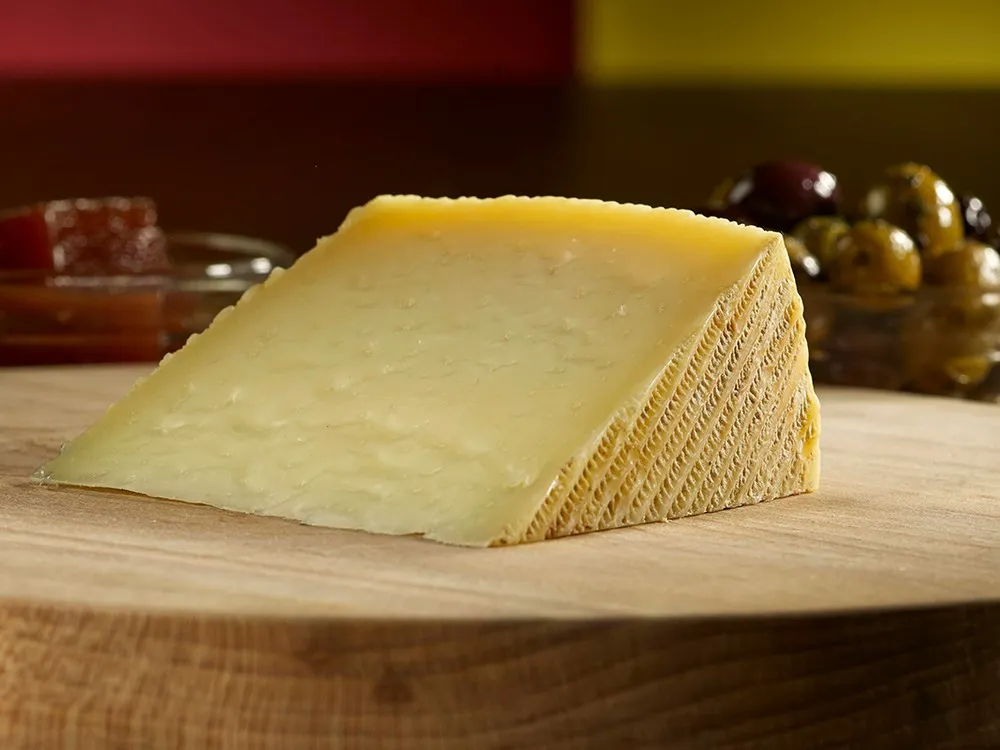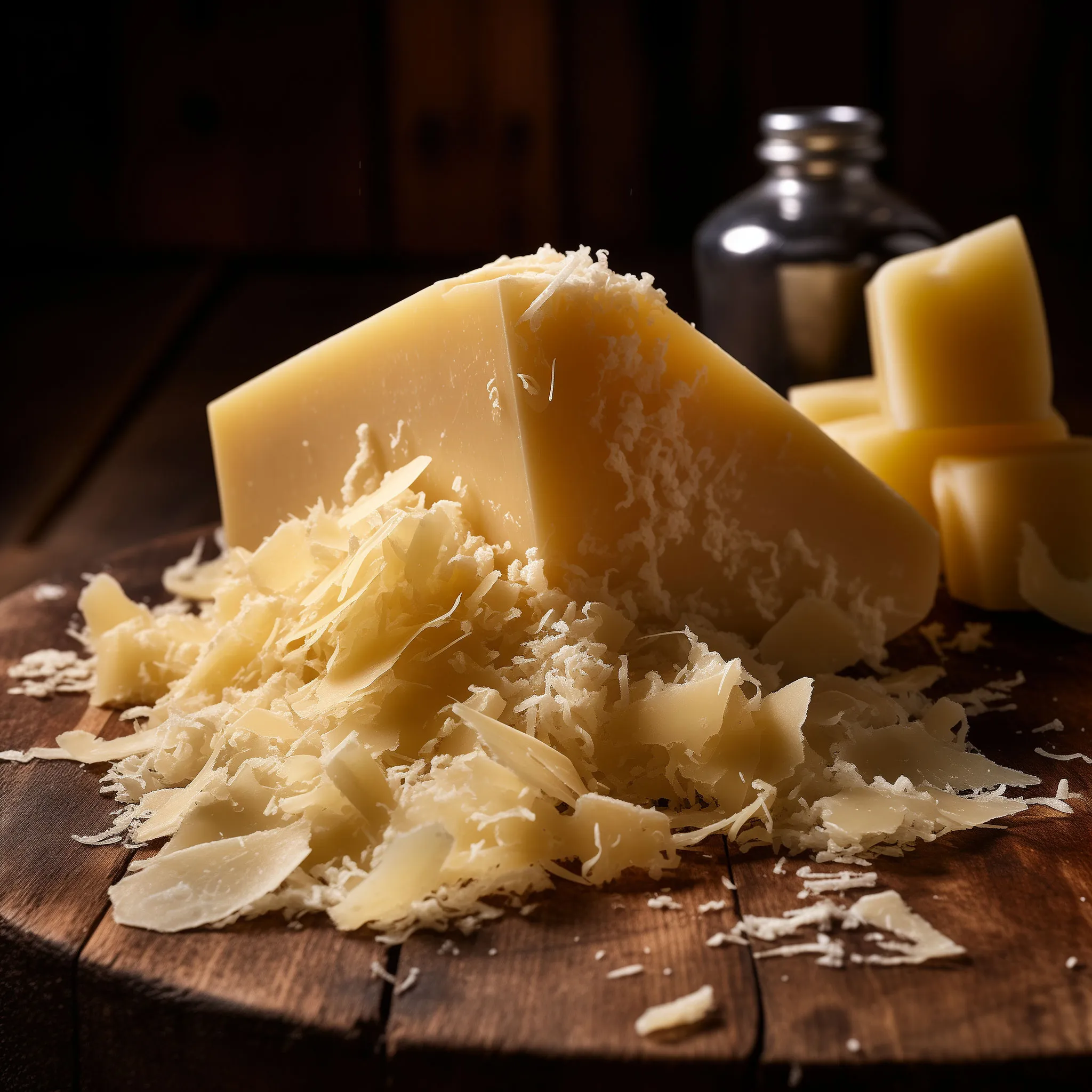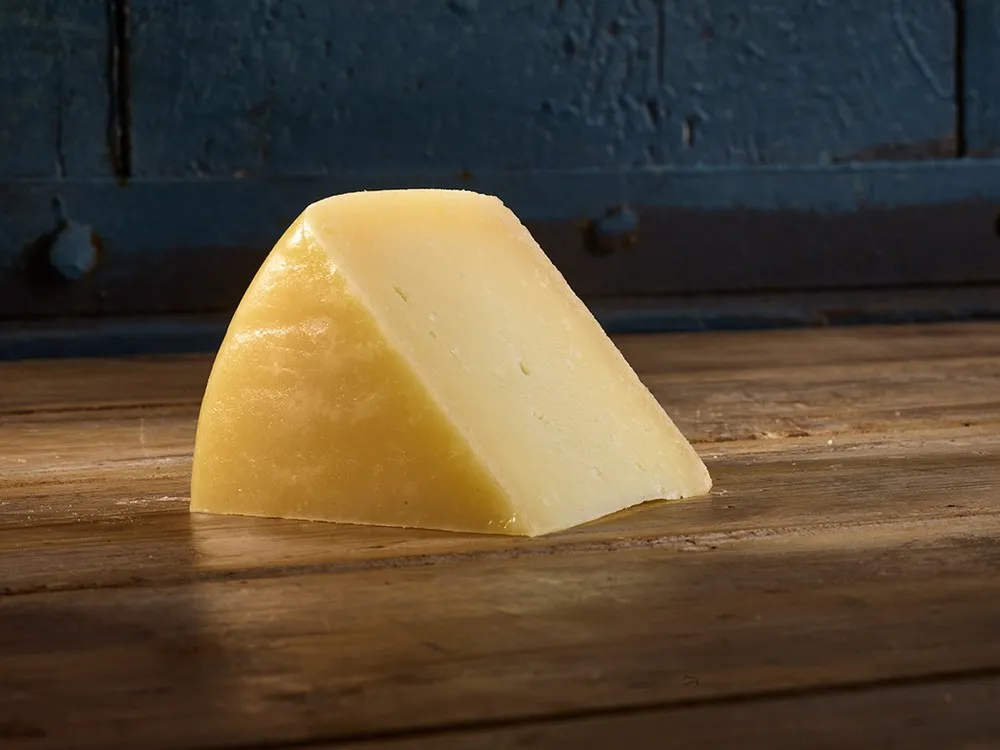Manchego
What Is Manchego Cheese? What Does Manchego Taste Like?
Manchego cheese, a popular type of cheese that originates from Spain, is a true culinary delight. Named after the region of La Mancha, which is famous for its sheep and dairy products, this cheese is made from the milk of Manchega sheep. It boasts a rich and unique flavor that many cheese lovers find irresistible.
Manchego cheese is typically aged for different periods, ranging from a few months to several years, and features a distinctive basket-weave (zigzag) pattern on its rind. The younger, milder versions are often used in dishes like grilled cheese sandwiches, while the older varieties develop a more intense flavor and are enjoyed with fruits and wine.
Manchego cheese is available in several varieties.
- Fresco: Fresh cheese matures for two weeks. The flavor is rich and mild and is rarely available outside Spain.
- Semi Curado: a semi-firm cheese aged around three weeks to three months. It is supple and moist with a fruity flavor and tangy notes.
- Curado: Another semi-firm cheese, although this one is aged for 3-6 months. The taste is subtle, with hints of caramel and nuts.
- Viejo: Firm cheese aged for 1-2 years. It has a sharp profile with a crumbly texture laced with rich, deep peppery top notes.
What Does Manchego Cheese Taste Like?
Manchego cheese has a distinct and delightful taste. Named after the arid plains of La Mancha in the heart of Spain, the cheese derives its outstanding nutty and caramel notes from the heat and dryness of the landscape, combined with the unique milk produced by sheep raised in such conditions. As with many cheeses, manchego's taste matures and intensifies with age.
Younger Manchego is mild and creamy, with hints of fresh grass and herbs. Aged Manchego acquires nutty undertones and a stronger, more complex taste.
The texture of Manchego cheese is also an essential part of the experience. When young, it has a semi-soft and slightly crumbly texture, which becomes firmer and more compact as it ages. Regardless, this cheese is wonderfully versatile, with a taste profile that appeals to a wide range of palates.
What Kind Of Cheese Is Manchego?
Manchego is a traditional Spanish cheese that falls under the category of a semi-hard cheese. It is exclusively made from the milk of Manchega sheep, a breed native to central Spain. The use of sheep's milk gives Manchego cheese its distinctive characteristics and sets it apart from other types of cheeses.
To be officially recognized as Manchego cheese, it must be made with at least 60% Manchega sheep's milk. The remaining percentage can come from other breeds, but it is often supplemented with sheep's milk to maintain the authentic flavor. The production process involves aging the cheese for a specific period, which further enhances its taste and texture.
What Is Manchego Cheese Used For?
The versatility of Manchego cheese is genuinely remarkable, allowing it to be used in a wide range of culinary applications. Whether enjoyed on its own or paired with other ingredients, this cheese never fails to impress. Here are some popular uses of Manchego that will surely inspire your next culinary creation:
- Serving on cheese platters: The distinct flavor and presentation of Manchego cheese make it an excellent addition to cheese platters. Pair it with some cured meats, olives, and fresh fruits for a delightful combination.
- Melting and grating: Manchego cheese melts beautifully, making it perfect for grilled sandwiches, quesadillas, and baked dishes. Its rich flavor adds a delightful twist to these recipes.
- In salads and sandwiches: Shave or grate Manchego cheese over salads and sandwiches to add depth and creaminess. It pairs well with a variety of ingredients like fruits, vegetables, and cured meats.
- In desserts: Yes, you read that right! Manchego cheese can also be used in desserts. Its unique taste complements the sweetness of fruits and honey, making it a fantastic addition to cheese-based desserts.
What Is Manchego Cheese Made Of?
Manchego cheese is made from the milk of Manchega sheep, a breed indigenous to the La Mancha region of Spain. These sheep graze on the natural vegetation of the region, which contributes to the distinct flavors in their milk. The cheese-making process involves several meticulous steps, each crucial in creating the unique taste and texture of Manchego cheese:
- Milk collection: The milk is carefully collected from the Manchega sheep and transported to the cheese production facility. It is important to maintain high hygiene standards throughout this process.
- Curd formation: The milk is heated and combined with rennet, an enzyme that promotes curdling. This causes the milk to curdle and separate into curds and whey.
- Molding and pressing: The curds are then carefully molded into the characteristic shape of Manchego cheese. The excess whey is drained off, and the cheese is pressed to remove any remaining moisture.
- Salt brining: After molding and pressing, the cheese is submerged in a brine solution. This helps to enhance the flavor and preserve the cheese during the aging process.
- Aging: Once brined, the cheese is aged for a specific period, typically ranging from a few weeks to several months. This aging process develops the flavors and textures that make Manchego cheese so unique.
How Long Does Manchego Cheese Last?
The shelf life of Manchego cheese largely depends on its age and storage conditions. As a general guideline, young Manchego cheese typically lasts for about three to four weeks in the refrigerator. However, it is best to consume it within two weeks for the best flavor and texture.
Aged Manchego cheese, on the other hand, can last for several months when stored properly. It is important to wrap the cheese tightly in wax paper or cling film to prevent it from drying out. Keeping it in a cool and dry place will help maintain its quality for a more extended period.
Where Is Manchego Cheese From?
Manchego cheese originates from the La Mancha region of Spain, which is located in the central part of the country. This region has a long-standing history of cheese production, with centuries of tradition and expertise.
Manchego cheese is deeply rooted in the cultural heritage of La Mancha. Its production methods and characteristics have been carefully preserved and protected through the designation of origin regulations. These regulations ensure that only cheese made within the specific region and following traditional methods can be called "Manchego."
How Much Protein In Manchego Cheese?
Manchego cheese is an excellent source of high-quality protein. It is particularly beneficial for individuals looking to increase their protein intake, such as athletes or those following a high-protein diet. The exact protein content may vary depending on the age of the cheese. Generally, a 1-ounce serving of Manchego cheese contains around 7-8 grams of protein.
Manchego Cheese Calories and Nutrition
Manchego cheese is a flavorful addition to any dish, but it's essential to be mindful of its calorie and nutritional content. Here is a breakdown of the approximate nutritional values for a 1-ounce serving of Manchego cheese:
- Calories: 126 calories
- Fat: around 10.1grams
- Protein: around 8.7 grams
- Calcium: 19% of the recommended daily intake
- Sodium: 5% of the recommended daily intake
Please note that these values can vary depending on the specific brand or age of the cheese. If you are following a specific dietary plan or have dietary restrictions, it is advisable to check the product labels or consult with a healthcare professional.
Manchego cheese is a delightful Spanish cheese with a unique taste and texture. Its nutty, sweet, and slightly tangy flavors make it a favorite among cheese connoisseurs. Whether enjoyed on its own, melted in dishes, or paired with other ingredients, Manchego cheese adds a distinct and delicious element to any culinary creation. Now that you know what Manchego cheese is, how it tastes, where it comes from, and how it's made, you can explore the world of this exceptional cheese with confidence.

Over 200,000 page views per month, Put your store on our map!
Contact UsOther Spanish cheeses:
If you're a fan of Manchego cheese but find yourself without it in the kitchen, don't worry! Several other delicious cheeses can be used as substitutes. Whether you're looking for a similar taste or texture, these versatile alternatives are sure to inspire your culinary exploration and satisfy your cheese craving. …
Read MoreManchego Q & A
-
Is Manchego Lactose-Free?
Manchego is made from sheep's milk, and as such, it naturally contains lactose, a type of sugar found in …
Read More -
Is Manchego Vegetarian?
When following a vegetarian diet, it's essential to be aware of the ingredients used in food products. Manchego cheese, …
Read More -
Is Manchego Gluten-Free?
For individuals with gluten intolerance or celiac disease, ensuring that the foods they consume are gluten-free is crucial. Manchego …
Read More -
Does Manchego Melt?
Manchego is a semi-hard cheese that contains some moisture, which enhances its melting ability. While it may not melt …
Read More -
How To Store Manchego?
Proper storage is essential to maintain the quality and flavor of Manchego. Storing it correctly will help prevent the …
Read More -
How Long Can Manchego Sit Out?
Manchego, like any perishable food, should not be left out at room temperature for an extended period. Bacteria can …
Read More -
Can You Freeze Manchego?
Freezing Manchego can alter its texture and affect its flavor.
We've all faced the dilemma of having an excess …
Read More -
Can Dogs Eat Manchego?
While Manchego is not toxic to dogs, moderation is key.
Dogs have a reputation for being eager eaters, and …
Read More -
Can Cats Eat Manchego?
While Manchego is not toxic to cats, it is good practice to be cautious about sharing it with them. …
Read More -
Can You Eat Manchego While Pregnant?
Many expectant mothers have concerns about what foods are safe to consume during pregnancy. Manchego, a famous, popular Spanish …
Read More






